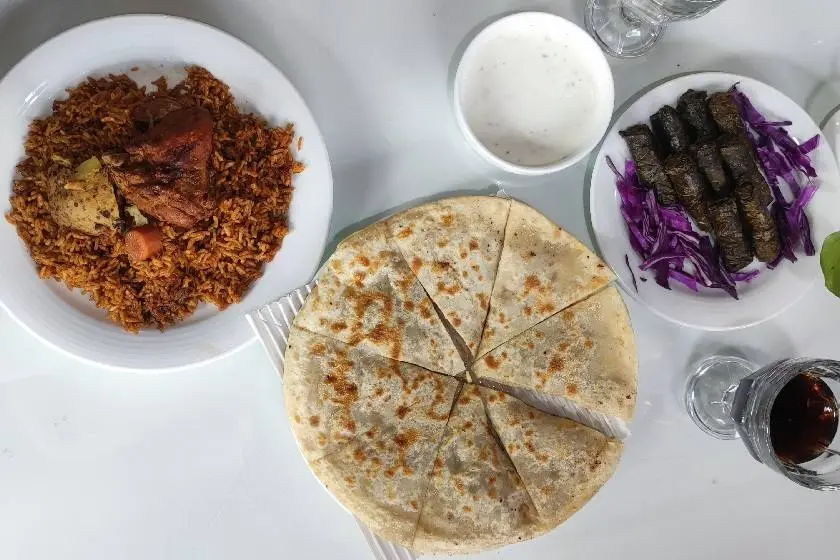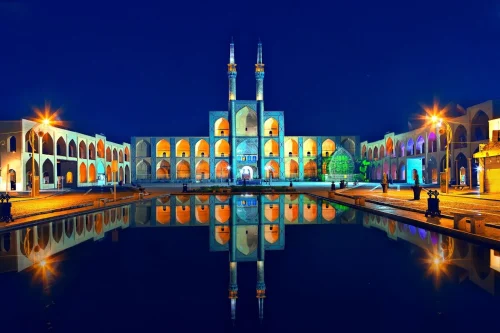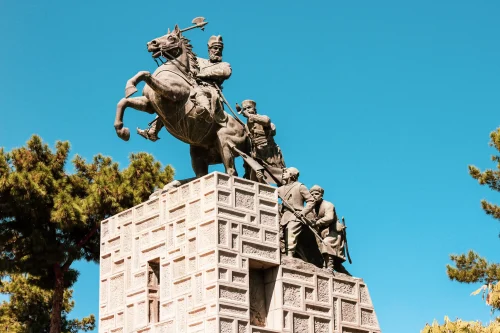Introducing Ramsar’s Local Foods | A Tour in the Delicious World of Ramsar’s Delicacies
Considering the culture and taste preferences of the people in northern Iran, it’s no surprise that we encounter a great variety of delicious local dishes. If you wish to learn about how to prepare Ramsar’s local foods like Malabij, Beej Beej, Baghela Vabij, Seer Anar stew, Aloo stew, Torsh Torsho, Naz Khatun, Beshteh Vash, Espenasak, Spinach Marji, Dupeti, Doaab, and most importantly Kadoo Bereh and Kaii Pola, stay with us through the end of this article from Otaghak Tourism Magazine. For more information about this city, you can read the Where is Ramsar article.
The local dishes of Ramsar not only include a wide range of traditional foods like Malabij and Ash Doogh but also offer unique flavors due to the use of fresh and natural ingredients such as zucchini and pomegranate. Furthermore, visiting Iran Charter will not only satisfy your palate but also provide a unique experience of local delicacies throughout the teahouses of Ramsar. Additionally, Iran Charter offers the best travel services, accompanying you in discovering the unique attractions of this city. Finally, Iran Charter ensures you have a pleasant memory of your trip to Ramsar and allows you to enjoy the local foods.
Introduction to Ramsar’s Local Dishes
Ramsar, with its lush greenery and mild climate, provides an ideal environment for a diverse local cuisine. Ramsar’s local dishes not only use fresh vegetables and high-quality ingredients but also feature unique preparation methods that endow each dish with an unparalleled flavor. Some popular regional dishes include Malabij, Bij Bij, Baghala Va Bij, Garlic Pomegranate Stew, Plum Stew, and Courgette Lamb. Each of these dishes tells a unique and traditional story that reflects the culture and history of this part of Mazandaran.
The Best Restaurants in Ramsar to Taste Local Cuisine
Choosing the right restaurant plays an important role in fully experiencing Ramsar’s local cuisine. Famous restaurants in Ramsar offer modern amenities while preserving local culinary traditions, making them the best places to savor authentic dishes. Iran Charter provides access to the best restaurants in Ramsar, helping you find the right spots to enjoy the delicious local foods. From traditional restaurants to chic urban spots, all options are available for your selection.
Secrets of Cooking Ramsar’s Local Dishes
One of the reasons why Ramsar’s local dishes are popular is their unique cooking methods. The use of special cooking techniques and fresh ingredients are defining features of these dishes. For instance, Malabij involves stuffing male fish with walnuts and pomegranate paste, then grilling it carefully to achieve an exceptional taste. Additionally, in the Garlic Pomegranate Stew, the combination of fresh garlic with sour pomegranate seeds offers a delightful taste experience. The secrets to cooking these dishes lie not only in the ingredients but also in the precision and artistry of their preparation.
The History of Ramsar’s Local Dishes
Ramsar’s local dishes have roots in the rich history and culture of this region. These dishes have evolved over time, influenced by various cultures. Cooking Ramsar’s local dishes is inspired by old family tales and the preferences of local people. For instance, Plum Stew, a combination of meat and pomegranate seeds, is symbolic of the people’s effort to utilize natural resources and produce from the orchards found in this city. The history of Ramsar’s cuisine reflects the close connection of its people with nature and the environment.
Must-Try Local Dishes in Ramsar
If you travel to Ramsar, overlooking the local dishes of this city would be a great mistake. Some dishes you must try include Malabij, Garlic Pomegranate Stew, Courgette Lamb, and Du Ab Ramsar. Each of these dishes offers a unique and unforgettable experience with its special taste and unique combination. Iran Charter facilitates easy access to these popular dishes by introducing the best restaurants in Ramsar.
Main Ingredients in Ramsar’s Local Dishes
The completeness of Ramsar’s local dishes depends on the use of high-quality and fresh ingredients. Key ingredients include pumpkin, fish, duck meat, pomegranate, walnuts, and aromatic herbs. The use of fresh pomegranate and walnuts in dishes like Garlic Pomegranate Stew and Aghuz Messama adds a distinctive taste and flavor to the dishes. Additionally, fresh vegetables and aromatic herbs enhance the nutritional value and pleasant taste of Ramsar’s cuisine. The quality of the ingredients plays a significant role in preparing Ramsar’s local dishes and is the first step in producing delicious and nutritious meals.
How to Prepare Local Soups of Ramsar
The local soups of Ramsar, especially Garlic Pomegranate Ashe and Du Ab, are among the nutritious and energizing foods that hold a special place in the daily meals of the city’s residents. The preparation of these soups involves unique combinations of aromatic vegetables, spices, and local ingredients. To prepare Garlic Pomegranate Ashe, fresh garlic is combined with sour pomegranate seeds and cooked with chicken and spices to develop a mild and delicious taste. Du Ab is made with local curd, meat, and aromatic herbs and is considered one of the nutritious dishes of this region. Local culinary art achieves unparalleled sophistication by combining these ingredients and using traditional cooking techniques.
Food Tips for Traveling to Ramsar
Traveling to Ramsar is a great opportunity to experience local foods and savor the unique flavors of northern Iran. During this trip, it is important to consider the following dietary tips: Firstly, choosing restaurants that use fresh and local ingredients ensures the quality of the food. Secondly, trying traditional dishes like Malabij and Garlic Pomegranate Stew not only offers a good taste experience but also acquaints you with the local food culture. Lastly, be sure to enjoy the local sour and tasty foods, such as Sour Sumac and Naz Khatun. Adhering to these tips will turn your trip to Ramsar into a delightful and memorable experience.
Tourists’ Experiences of Ramsar’s Dishes
Many tourists, after traveling to Ramsar, highly appreciate the local dishes of this city. Their positive experiences often include the unique taste of local dishes such as Malabij, Plum Stew, and Courgette Lamb. Tourists are amazed by the variety and quality of ingredients used in these dishes and describe them as an inseparable part of Ramsar’s culture. Iran Charter helps provide a comprehensive tourist experience, including introducing reputable restaurants and authentic Ramsar local foods so that tourists can have the best culinary experiences during their trip.
Differences between Ramsar’s Local Dishes and Other Northern Iranian Regions
While Ramsar’s local dishes share many similarities with other northern Iranian cuisines, they have specific features that set them apart. For example, the use of male fish in Malabij preparation or the unique combination of curd with meat in Du Ab are just a few examples of these visual differences with other regions. Additionally, the combination of spices and the use of sour pomegranate as a flavor enhancer provide Ramsar’s cuisine with a distinctive and unique taste. These differences reflect the cultural and environmental diversity of the Ramsar coasts, which has contributed to the growth and formation of diverse local foods.
FAQ
- What is Malabij and how is it prepared?
- Malabij is one of the most famous local dishes of Ramsar, made from male fish, walnuts, pomegranate paste, and spices. The cleaned fish is stuffed and then grilled over a fire or cooked in a microwave.
- What are the features of Garlic Pomegranate Stew?
- Garlic Pomegranate Stew combines the delightful aroma and flavor of garlic with pomegranate seeds, chicken, onion, pomegranate paste, spices, sesame seeds, and saffron. Its mild and unique taste makes it very popular.
- What is Beshteh Wash and what benefits does it have?
- Beshteh Wash is one of the local and nutritious soups of Mazandaran, made from lentils, cumin, spinach, onion, and various traditional spices. It is rich in iron and fiber, making it very beneficial for individuals with anaemia.
- How is Bij Bij prepared?
- Bij Bij is prepared by combining ground meat, potatoes, tomatoes, onions, and spices. First, onions and meat are sautéed, then cooked tomatoes are added, and finally, fried potatoes are placed on top.
- What is Sour Sumac and how is it served?
- Sour Sumac is a stew made from sumac, chicken or meat, red beans, aromatic herbs, and onions. This stew has a sour taste and is served with rice or bread.
- What is Naz Khatun?
- Naz Khatun is a delicious local Ramsar dish made from eggplant, pomegranate paste or juice, hogweed, verjuice, onion, dried mint, fresh basil, garlic, and tomatoes. It is served as a popular condiment alongside other dishes.
- Where is Courgette Lamb Dish from?
- Courgette Lamb is a dietary and popular dish in Ramsar, made from potatoes, eggs, tomatoes, zucchini, onions, garlic, and spices. It is usually served with bread and vegetables.
- What is Espanasak and how is it prepared?
- Espanasak is a Mazandaran spinach stew made from lamb, spinach, aromatic herbs, carrots, spices, garlic leaves, onion, and mint. It is rich in vitamins and protein and is both healthy and nutritious.
- What is Kayi Pola?
- Kayi Pola is an authentic and delicious Ramsar dish made from pumpkin, minced meat or chicken, cumin, local butter, rice, onion, and spices. This dish is typically served with egg and yogurt.











